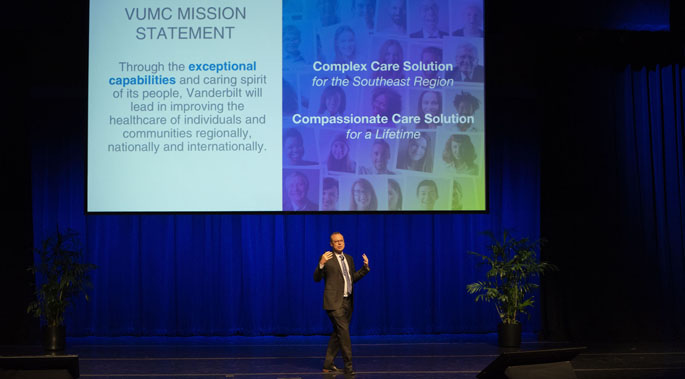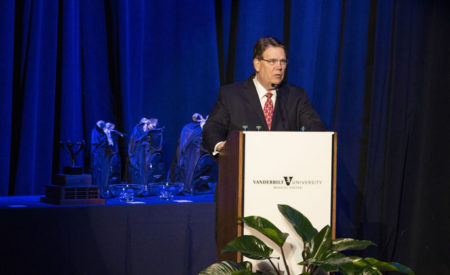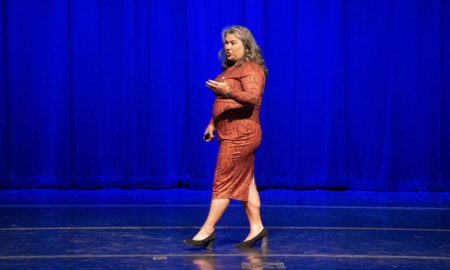
by Holly Fletcher
The exceptional capabilities that stem from the fusion of research and training with clinical practice is the core of Vanderbilt University Medical Center’s longstanding success and is the philosophy underpinning an era of unprecedented growth and partnerships around the region.
“It’s important to recognize the expertise and collaboration in all corners of the enterprise that enable the Medical Center to approach a new era with a focus on growth, particularly emphasizing capabilities that further distinguish us as a unique resource in the region,” said Jeff Balser, MD, PhD, President and Chief Executive Officer of VUMC and Dean of Vanderbilt University School of Medicine, at the November Leadership Assembly.
“I think of VUMC as a melting pot of capabilities. There’s not a clinical enterprise and an academic enterprise — we merge the two together. Our training and research programs are fundamental in making us a leader in complex care. We are innovative and groundbreaking not because these coexist, but because they work together,” said Balser. “With exceptional capability all around we get used to it and it feels normal — but it’s not normal. It’s what sets us apart and why people look to us for solutions and lifesaving care.”
What’s a Leadership Assembly?
Leaders from all parts of the Medical Center meet to get updates on progress, growth, trends and share those key messages with their own teams. The priorities shared each quarter are to highlight how teamwork and cooperation are vital to the strength of VUMC. Video clips and presentations are available to all employees at the Elevate website.
Here’s what to know from the Nov. 13th Leadership Assembly:
- Melrose to Wilson County to Murfreesboro
Designing growth to accentuate the special expertise of VUMC is central as the Medical Center increases its physical presence around the region with new walk-in clinics, specialty care sites, and expanded service lines.
The integration of Vanderbilt Wilson County Hospital into the IT and clinical infrastructure is underway with plans to expand the services offered on-site within the year as well as at new, area clinics. Patients will be able to get a broader array of behavioral health, gastroenterology, and obstetrical and women’s health services as well as specialty cancer treatments at a Vanderbilt-Ingram Cancer Center at Wilson County that’s set to open July 1, 2020.

“We each contribute to something much greater than ourselves and together we make a tremendous impact on so many people. Our goal is to support this community hospital with new resources,” said C. Wright Pinson, MBA, MD, Deputy CEO and Chief Health System Officer.
Vanderbilt Health recently opened a walk-in clinic and adjacent primary care on 8th Avenue in Nashville. It’s rolling out services at Monroe Carell Jr. Children’s Hospital at Vanderbilt’s new surgery and clinics facility in Murfreesboro, and is planning a variety of care, including hand surgery and cancer chemotherapy treatments, at the former Harris Teeter grocery in Belle Meade.
- Fine tuning where and how people ‘see’ Vanderbilt
The new locations are a component of VUMC’s strategy to connect patients with the care they need, when and where they need it. The evolution of the Middle Tennessee region and the network of hospitals around the state is reshaping how and where people get care.
Medical Center leaders will use the growing web of clinics and outpatient centers as well as partner hospitals to “tune acuity,” or focus on keeping lower acuity patients closer to their home while ensuring the people who need the most complex care are brought on-site, said Balser. The Vanderbilt Health Affiliated Network is vital to successfully getting people to the appropriate setting.
The inpatient expansions that are set to open soon underscore the rising demand for specialized care and emphasize the need for regional collaboration and thoughtful consideration of what care setting works best for patients, Balser said.
Teams and clinics are encouraged to think about how telehealth services can be woven into the daily practice as a way to administer specialty expertise, without the expense and commitment of travel.
“With the success of many existing telehealth programs, such as tele-neurology, we are really becoming a major force in telehealth. This is important because not only is the Nashville population growing rapidly, but we also want to ensure people all across the Mid-Southern region can access primary care as well as our specialty care services,” said Balser.
- The bottom line
Fiscal year 2020 is off to a strong start. The Medical Center is meeting many of its first quarter benchmarks and is on track to hit more milestones at the end of the year. The three focus areas for this fiscal year (July 1, 2019 – June 30, 2020) are service and access; volume; and expense management, said Pinson.
The Medical Center received an improved outlook from Moody’s Investors Service on its “A” bond rating, from negative to stable, a pivotal milestone after the Epic implementation, said Balser.
Continued focus on expense management throughout all departments will provide additional resources that VUMC can utilize on important initiatives that will improve overall workplace satisfaction, including market-driven compensation increases, said Pinson.
- Advance Directives
As articulated at a prior Assembly, VUMC is working to increase the number of patients with advanced directives guiding their care at the end of life. As a way to encourage patients, Balser is encouraging all Assembly participants to complete their advanced directive, and eventually all VUMC employees. “There are very few things we can all do to very rapidly improve health care in this region, but this is one. The impact is massive,” said Balser. As of this week, MyHealth portal allows users to upload the advanced directive form directly from home, eliminating the need to work through a VUMC clinician, unless desired by the patient.
- ‘What does great look like?’

Cy Wakeman, president of Reality-Based Leadership, talked about training our behavior to reframe moments of frustration. (photo by Joe Howell)
At the assembly, Cy Wakeman, president and founder of Reality-Based Leadership, talked about training our behavior to reframe moments of frustration into reality checks that focus on what improves the moment or circumstance — moving past the unreality of what could be. Wakeman explained how “drama” and negative dialogue can snowball into a drag on efficiency, morale and results.
She challenged people at all levels to reflect on a situation when irritation is the instinct and ask instead, “what does great look like?” A characteristic of the modern workforce is “an aggressive agenda with limited resources,” she said, so accepting that condition as reality is a more functional path toward adaptability and workplace satisfaction.












